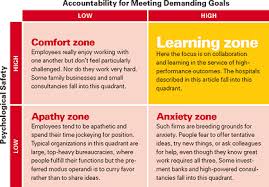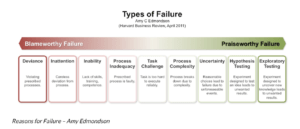I really appreciate being directed to the work of Amy Edmondson and “Teaming”. Her work is well written, includes case studies, and reinforces that the way we worked is no longer going to get us where we need to be going.
Teaming is not a natural leadership stance, or a natural cultural stance within organizations. But it can, and could be.
Educational institutions are conservative in nature, mindsets and operations; however, research, examples and lived reality are demanding innovation. This makes the landscape of education fraught with tension, discomfort, unpredictability and it is challenging what educators know, and the routines they have come to rely on. At the school level, there are innovations happening, succeeding, being diluted and failing, but we are out there trying.
The real tension comes when we step back and acknowledge that schools are not set up for innovation. We are siloed in grades, disciplines, ages, geographically on the campus, etc… If what my last post explored holds true, we need a new way of working in schools. Enter the “Teaming” approach.
Written in 2012, this book still holds up, and in fact may be more significant now in the Covid-19 reality. This is a book about how we work, and how we might work to deliver “Complex” and “Innovative” projects.
You would be interested in this book if…
1) You are a school leader looking to lead through digital, cultural and educational transformations
2) Involved in innovation projects and how to be a great collaborator
3) Looking to understand how to work with others
4) You want to understand Psychological Safety in organisations
5) You are involved in school change and want it to succeed 🙂
What is Teaming?
Teaming is a way of working that combines how we relate to one another, how we listening and what we are listening for, the coordination of our actions and how we share decision making. (pg. 2) Teaming requires a shift in leadership from providing answers to asking questions, and it requires a relook at how teams come together. “[Teaming] is largely determined by the mindset and practices of teamwork, not by the design and structures of effective teams.” (pg. 13).
 It acknowledges the necessary changes required to succeed in today’s VUCA landscape. We are coming out of the Ford/Thorndike era and moving into an era of creativity, distributed leadership and the age of IDEO. Fear no longer plays a role, the boss as overseer is not always useful, and “The narrow focus on getting things done inhibits the experimentation and reflection that are vital to sustainable success in an unpredictable and evolving [educational] environment.” (pg. 21)
It acknowledges the necessary changes required to succeed in today’s VUCA landscape. We are coming out of the Ford/Thorndike era and moving into an era of creativity, distributed leadership and the age of IDEO. Fear no longer plays a role, the boss as overseer is not always useful, and “The narrow focus on getting things done inhibits the experimentation and reflection that are vital to sustainable success in an unpredictable and evolving [educational] environment.” (pg. 21)
The organization that will truly excel in the future will be the organizations that discover how to tap people’s commitment and capacity to learn at all levels in an organization. – Peter Senge (pg. 22)
Teaming has key benefits:

But the biggest challenge to “Teaming” is this: Teaming is something that is unnatural in the way we are wired, in the way institutions and organizations are built, and “Teaming” requires a new cultural build.
Organize-to-Learn + Execute-to-Learn
This is a great concept that this book builds upon. These concepts of Learning are built upon Teaming being in place, in a cycle of feedback and learning. “The defining attribute of execution-as-learning is its integration of constant, unremarkable, small-scale learning into day-to-day work.” (pg. 31)
A great example for the education-sector is the idea of surfacing tacit knowledge, especially now in a technology enabled environment:
Some things you just have to be on site to know. And because this kind of knowledge [tacit knowledge] is taken for granted, people often don’t realize that what they know is important to share. It is also the case that these kinds of knowledge boundaries often coexist with [other] boundaries, which further raises the communication hurdle. – Pg. 207)
So, it isn’t just that schools are siloed, there is also the role that tacit knowledge plays when it remains underground and when it is surfaced.
Process Knowledge Spectrum
This is a spectrum of “Routine”, “Complex” and “Innovative” operation. Schools, by definition are “complex”, but now trying out innovative projects. How do we square this evolution from a societal and cultural institution that was once seen as routine, to now trying to be innovative?
As I learned from “Failure to Disrupt”, the increasing uncertainty, and the distance travelled away from the routine, the more uncomfortable it gets. Thus, complex and innovation projects/operations require a human way of doing things. Nothing is more human than Teaming.
The Role that Leaders Play
Thus, leaders play a crucial, relatively new, role in this shifting landscape. They should ask more questions, listen more and connect more. These are things that I strive to do – overcoming the institutional and cultural obstacles to support our faculty and students in a very human way.
Teaming leadership looks at 4 key attributes:
1) Identify the nature of challenges and conflicts – what is at the core of these challenges
2) Model good communication – be thoughtful, employ empathy and hold space
3) Identify Shared Goals – be aware of attribution errors
4) Encourage Difficult Conversations – challenge and tension build resilience when done in respectful ways that honour being human
Psychological Safety
This is a social construct that describes a work climate characterized by interpersonal trust and mutual respect. It is not about being congenial, it is about being collegial: driving a culture of continuous improvement. Easier said than done.
Research has shown, however, that most people feel the need to manage their image in front of others, especially at work, unless efforts have been made to counteract this natural tendency by establishing a learning environment…Fortunately, research also indicates that skilled team leaders can reward excellence, sanction poor performance, and still embrace the inevitable errors that accompany teaming and learning. In other words, it’s possible to have both a high psychological safety and high accountability. (Pg. 146)
Psychological safety is a harder hurdle to overcome in institutions, like educational institutions, because of the formal hierarchy and silos that already exist. Also, leaders can be prone to act in ways that stifle psychological safety and the ability to learn. “Intellectually, leaders may endorse psychological safety or the voice and participation it enables, but it’s not always easy to forgo the raised voices or angry expressions that signify dominance in a hierarchical system. And for others, it’s not easy to stop, stand one’s ground, and speak up. Instead, it’s easier and more natural to flee into the safety of silence.” (Pg. 135)
Establishing Psychological Safety is about action. You cannot just talk the talk as a leader. You must, across all departments, roles and interactions build a willingness to discern, what Edmondson calls, “Blameworthy and Praiseworthy Errors”.
The key takeaway is to take practical steps. Psychological safety is based on shared experiences of curiousity and language of learning. Actively being curious about why decisions were made. Using the above spectrum can be very helpful.
Upon reflection, this is a foundational text, full of research and great case studies that affirms and validates approaches that I have adopted (sometimes not always successfully) and try to integrate into my craft and role as an educational administrator. Edmonston’s work resonates with what we are learning from neuropsychology, from change management and from design thinking approaches.



Hey Garth, thanks for posting this review… I just ordered the book! 🙂